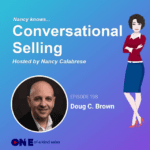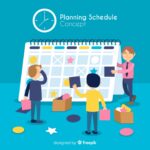by Marta Malyk | Nov 22, 2022 | Advice, Best Sales Practices, Sales efficiency, Sales Tips, Sales Training
I was recently at a meeting about sales efficiency where a debate broke out about what salespeople should do when a prospect says, “I’ll think about it.” Participants were divided. Some felt that this meant that the selling process was not complete and they should continue to engage the prospect. Others strongly believed that once a prospect tells you “I’ll think about it,” they should move to the next prospect. I firmly believe you should move on.
As a professional salesperson, I’ve had hundreds of conversations with prospects over the years. Because I’m focused on my sales objective and the need to be efficient with my time, it’s critical to know when to move on. We all know that we should not rush to close a prospect. We all know that we should be looking for signs to disqualify a prospect throughout the discussion. When these signs appear early, perhaps it’s easier to recognize that the prospect is not a fit for our solution and end the discussion. But when the signs show up later, they can be more difficult to recognize, perhaps because we are more emotionally invested. But that verbal message, “I’ll think about it” is a clear red flag to me. To confirm whether it’s really time to move on, I might ask, “Is there anything else I can tell you?”, and if the prospect says “yes,” I will address the question. But if the answer is “no,” then it’s clearly time for me to move on.
Why move on? Continuing to sell to a person who is telling you that they need to think about it after you’ve had robust discussions delays you from moving to a prospect that you might be able to more readily convert. Frankly, “I’ll think about it” is really the kiss of death. Experience tells me that this prospect is not likely to make a positive decision and I would be wasting time continuing the conversation.
You may be thinking, ‘well I’ve spent all of this time getting to know this prospect and I hate to let it drop.’ But that is not what you should do. You should move the prospect into a nurturing program with a plan to revisit them at some point to see if conditions have changed.
It might be very attractive to continue discussions with someone with whom you’ve already developed a relationship in the hope that they will convert. But you really are fooling yourself. We need to be clear-eyed about what’s going on in a sales engagement. Ideally, we never ask for the sale until the time is right. At that point, if they say they still need to “think about it,” it’s time to gracefully move on.
At One of a Kind Sales, we love selling and we are experts at sales and cold calling, in particular. If you would like to discuss how we can help you and your team please contact us at 908-879-2911.
by Marta Malyk | Oct 24, 2022 | Best Sales Practices, Closing Sales, Sales efficiency, Sales process, Sales productivity
As business owners, we all want to grow by winning new clients. But many of us find it difficult to “convert” new opportunities into paying clients. This leads to frustration.
In my 20+ years of experience as a sales professional, I’ve observed that many business owners meet prospects and then immediately move forward to “sell” without taking a pause and assessing what needs to happen next. They don’t actively manage the selling process. There are four actions you can take to help increase your sales efficiency.
Step 1—Talk to the Real Decision Maker
There is nothing more frustrating than discovering that you’ve walked through an entire sales process only to discover that your prospect needs to bring in another party who will ultimately make the decision. The step of confirming that your contact is the real decision maker is often overlooked. We get excited over the prospect of new business with a long-sought company and it’s easy to assume that our contact holds more power than they do.
Make sure you explore the company’s decision-making process with the person who is your contact. Be prepared to say you can only go so far in the process without having the ultimate decision makers involved. Your likelihood of getting to a commitment is greater when you speak directly to the decision maker(s).
Questions you can ask to move this along are:
- What is the decision-making process for services or products like mine?
- Who else will be part of the decision making?
- Are there other major stakeholders who would be involved in the decision?
Step 2—Ensure Your Solution is Relevant
It’s better to learn quickly if there is no current opportunity with a target company rather than to invest your time selling to someone who doesn’t need or value the solution you offer. Once you confirm that you have a relevant solution, take time to understand how the problem has impacted their business. This allows you to adjust your discussion to speak directly to their experiences. It may feel unnatural to not push to a close immediately upon confirming their need. But if you invest your time in this dialogue, your prospects may actually sell themselves. They are reminding themselves why they should be talking to you. And they realize that you are listening to them. This makes them more amenable to moving forward.
Ask the following questions:
- How has this problem affected your business? And for how long?
- What resources has this problem consumed? What did it cost you?
- What have you already done to address it?
Step 3—Seek Confirmation Along the Way
Throughout the discussion, make sure that you are getting mini buy-ins. Check for agreement at key points, ideally using open-ended questions. Don’t wait until the end of your presentation to ask their opinion. This way, you’ll be able to assess your prospect’s level of engagement, confirm their interest, and address potential objections as they occur. Moreover, this approach will ensure that this is a two-way conversation.
Use these prompting questions:
- How consistent is this with what you experienced?
- What are your thoughts on this?
- How does this sound to you?
Step 4—Let Your Personality Shine Through
Throughout the engagement, never forget that “people buy from other people.” Let your personality shine through! If you are staying true to steps 1 though 3, your empathy for their situation will be apparent and you’ll build credibility and trust. Ultimately, you want your prospects to feel good and look forward to working with you.
Getting to the Close
Using this approach, the natural outcome of a discussion between you and your prospect is to move to a proposal.
- You are talking to the right person.
- You know they have a problem that you can solve.
- They’ve validated for themselves that they have this need.
- They know that you have a deep understanding of their situation.
By the time you get to this point, your prospect should have reached the unavoidable conclusion that your solution is just what their business needs.
Here’s the final piece of “magic”—if you’ve taken these steps, once you are ready to close, you can simply ask, “What would you like to happen next?”
When you get your next opportunity, take a step back, consider this guidance, and see what happens.
If your business is facing sales-related challenges, please reach out to us at 908-879-2911. At One of a Kind Sales, we are experts in sales and we particularly love cold calling. We look forward to speaking with you!
This article, written by Nancy Calabrese of One of a Kind Sales, originally appeared in The Bottom Line, No. 3: 2022, the quarterly newsletter of NJAWBO, New Jersey Association of Women Business Owners.



